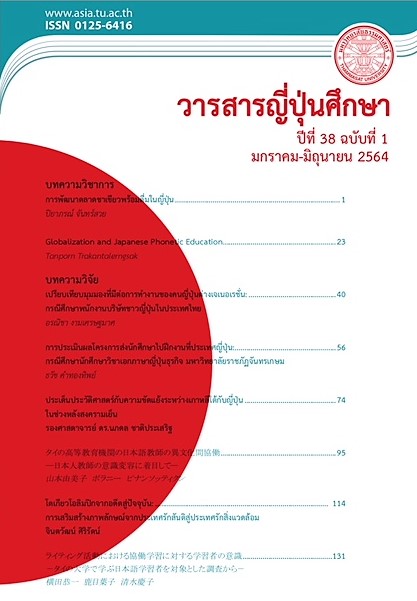ライティング活動における協働学習に対する学習者の意識 -タイの大学で学ぶ日本語学習者を対象とした調査から-
A study of JFL learners at a Thai university
คำสำคัญ:
collaborative writing, collaborative learning, learners’ target language use, , Japanese language learning, Thailandบทคัดย่อ
This study sets out to investigate learners’ attitudes and perceptions towards collaborative
writing in Japanese as a foreign language (JFL) setting and makes a proposal for Japanese
writing education at higher educational institutions outside Japan. Thirty-two learners at a
university in Thailand were instructed to complete a script-writing task for an oral presentation
in pairs as part of their classroom activities in Japanese. Subsequently, the learners received
a post-task questionnaire reflecting on their collaborative writing experience. The results
indicated that the learners’ reactions to the collaborative writing experience with their peer
and the use of the target language (TL) throughout the writing process were both overall
positive. Furthermore, most of the learners found positive impacts of collaboration with their
peer in their TL in 1) the content of their script, 2) the grammatical and lexical accuracy
of their script, 3) their grammar and vocabulary learning, 4) development of not only their
writing skills but also other language skills and abilities, and 5) their attitudes towards
learning Japanese. Findings showed the benefits of collaborative writing between peers in the
TL in a JFL setting and suggested the active implementation of it henceforth.
Downloads
เอกสารอ้างอิง
2. Donato, R. (1994). Collective scaffolding in second language learning. In J.P. Lantolf & G. Appel (Eds.), Vygotskian Approaches to Second Language Research (pp. 33-56). Norwood, NJ: Ablex.
3. Fernández Dobao, A. (2012). Collaborative writing tasks in the L2 classroom: Comparing group, pair, and individual work. Journal of Second Language Writing, 21, 40-58.
4. Fernández Dobao, A. & Blum, A. (2013). Collaborative writing in pairs and small groups: Learners’ attitudes and perceptions. System, 41, 365-378.
5. Kanome, Y. (2014). Approach to enrich skills in Japanese speech: A study with peer-response and evaluation activity in a speech class. The Japan Foundation, Bangkok Journal, 11, 51-60. (in Japanese)
6. Kanome, Y., Ebara, M., & Ohashi, M. (2021). Proposal of business Japanese textbook for new era: Toward training Action, Thinking and Teamwork. BJ Journal, 4, 2-15. (in Japanese)
7. Kanome, Y., Yokota, K., Ishizaki, D., Shinohara, E., Narita, Y., & Nishida, N. (2015). The role of the SEND program for the tertiary educational institutions in Thailand: The practice of the Japanese language instruction, instruction support, and exchange activities. The Japan Foundation, Bangkok Journal, 12, 67-76. (in Japanese)
8. Kwon, C. (2014). Student perspectives on group work and use of L1: Academic writing in a university EFL course in Thailand. Second Language Studies, 33(1), 85-124.
9. McDonough, K. (2004). Learner-learner interaction during pair and small group activities in a Thai EFL context. System, 32, 207-224.
10. Ministry of Economy, Trade and Industry. (2006). Shakaijin kisoryoku ni kansuru kinkyuu chousa. Retrieved 24 March 2021, from http://ono-tera.com/sanko-shiryo_syakaijinkiso.pdf (in Japanese)
11. Nunokawa, H. (2018). Rangeejingu no L2 bunpou shuutoku ni taisuru kouka: Shoki fiidobakku ni okeru sokushinteki yakuwari. Bulletin of the Institute for Excellence in Higher Education, Tohoku University, 4, 339-353. (in Japanese)
12. Sanprasert, N. (2010). The application of a course management system to enhance autonomy in learning English as a foreign language. System, 38, 109-123.
13. Shehadeh, A. (2011). Effects and student perceptions of collaborative writing in L2. Journal of Second Language Writing, 20, 286-305.
14. Storch, N. (2001). How collaborative is pair work? ESL tertiary students composing in pairs. Language Teaching Research, 5(1), 29-53.
15. Storch, N. (2005). Collaborative writing: Product, process and students’ reflections. Journal of Second Language Writing, 14, 153-173.
16. Swain, M. (2000). The output hypothesis and beyond: Mediating acquisition through collaborative dialogue. In J.P. Lantolf (Ed.), Sociocultural Theory and Second Language Learning (pp. 97-114). Oxford: Oxford University Press.
17. Swain, M. (2006). Languaging, agency and collaboration in advanced second language proficiency. In H. Byrnes (Ed.), Advanced Language Learning: The Contribution of Halliday and Vygotsky (pp. 95-108). London: Continuum.
18. Thomson, C.K. & Masumiso, H. (1999). Kaigai ni okeru nihongo kyouiku katsudou ni sankasuru nihonjin kyouryokusha: Sono mondaiten to kyoushi no yakuwari. Japanese-Language Education around the Globe, 9, 15-28. (in Japanese)
19. Tsuda, H. (2015). Positive and negative factors that affect collaborative learning. Journal of the Japan Association for Developmental Education, 10(2), 143-151. (in Japanese)
20. Wang, W. (2014). Chuugokujin gakushuusha no kyoudou gakushuu ni taisuru ishiki: Dhikutogurosu o keikenshita gakushuusha o taishou ni. Journal of Japanese Language and Culture, 10, 31-49. (in Japanese)
21. Watanabe, Y. & Swain, M. (2007). Effects of proficiency differences and patterns of pair interaction on second language learning: Collaborative dialogue between adult ESL learners. Language Teaching Research, 11(2), 121-142.
22. Yokota, K. & Kanome, Y. (2017). Significance and future vision of short-term exchange programs between students of Japanese and Thai universities: From the perspective of learners and teachers in Thailand. Japanese Studies Journal, 34(2), 1-15. (in Japanese)




